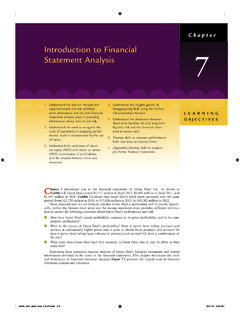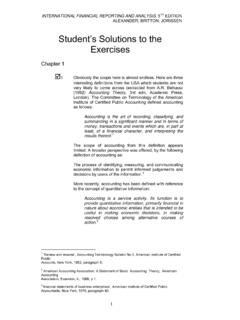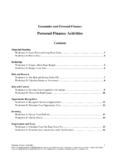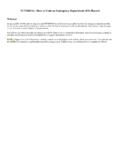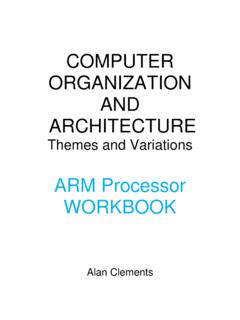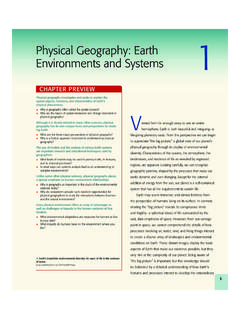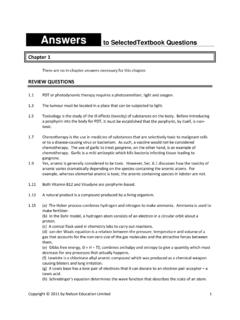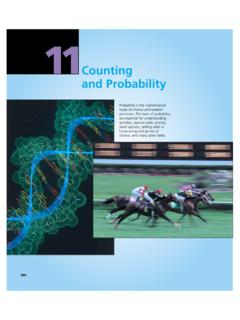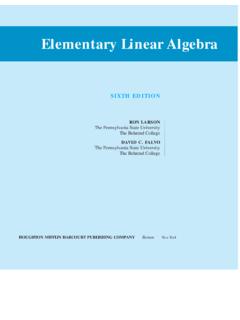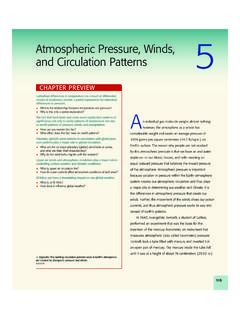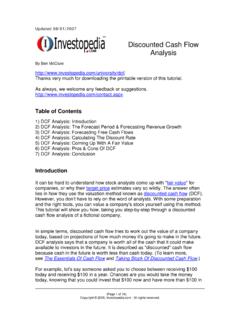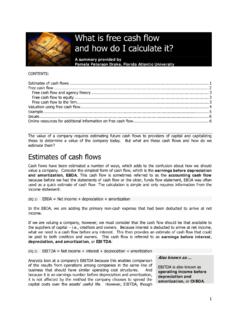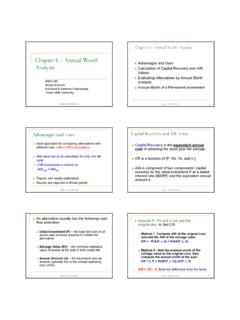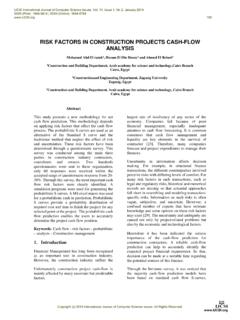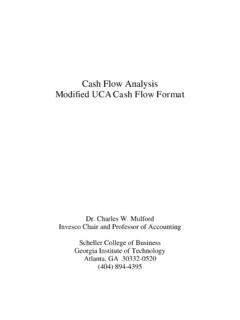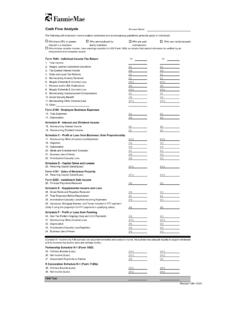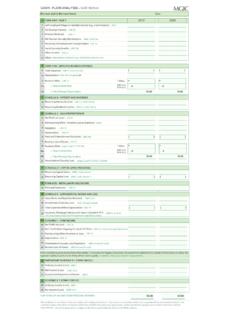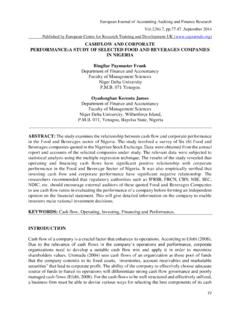Transcription of Chapter 2 Financial Statement and Cash Flow Analysis
1 5 Chapter 2 Financial Statement and cash flow AnalysisAnswers to Concept Review Questions1. What role do the FASB and SEC play with regard to GAAP?The FASB is a nongovernmental, professional standards body that examinescontroversial accounting topics and then issues rulings that almost have the force oflaw, at least in terms of their impact on accounting practices. In the the FASB hasdeveloped the GAAP (Generally Accepted Accounting Principles) as the set ofaccounting rules for companies to comply with in the preparation of their financialstatements. The Securities and Exchange Commission (SEC) is responsible for regulatingpublicly traded companies, as well as the nation s stock and bond markets.
2 Itmonitors the compliance of publicly traded companies with the GAPP. The four keyfinancial statements required by the SEC are (1) the balance sheet, (2) the incomestatement, (3) the Statement of retained earnings, and (4) the Statement of cash Are balance sheets and income statements prepared with the same purpose in mind? Howare these two statements different, and how are they related?Balance sheets and income statements both are prepared for the purpose of providingfinancial information about a company at a point in time. A balance sheet provides apicture of the company s assets and liabilities, or net worth at a point in time, and sumsall of the company s past earnings in the shareholder equity account.
3 An incomestatement provides a picture of the company s revenues and expenses for a specifiedperiod of time. Both statements are very useful in analyzing the company s past Which statements are of greatest interest to creditors, and which would be of greatestinterest to stockholders?Creditors would most likely be interested in the balance sheet, which states how much inliabilities the company has, but they also would want to see an income Statement , whichtells the company s ability to meet its payment commitments. Shareholders will certainlybe interested in the balance sheet and income Statement , which will allow them tocompute ratios for the company, in the Statement of retained earnings which states howmuch their share of the company has increased or decreased and in the Statement of cashflows, which describes where cash is coming into and going out of the How do depreciation and other noncash charges act as sources of cash inflow to the firm?
4 Why does a depreciation allowance exist in the tax laws? For a profitable firm, is it betterto depreciate an asset quickly or slowly for tax purposes? and other non-cash charges are sources of cash to the firm. These chargesare subtracted from the firm s revenues, decreasing cash flow in order to get a correct6 Y Chapter 2/ Financial Statement and cash flow Analysisestimate of taxes owed. They need to be added back to compute an accurate cash charges are not real cash flows no dollars exchange hands when a companytakes a depreciation expense and are only subtracted because they reduce thecompany s tax bill, and taxes are a real dollar cash flow .
5 The tax code does not allow acompany to expense its capital equipment in the year it was purchased. It requirescompany s to charge this expense over the lifetime of the equipment, taking a percentageof the total cost each year. For a profitable firm, it is better to depreciate assets asquickly as possible. The larger the depreciation expense, the lower the taxable incomeand the lower the taxes What is operating cash flow (OCF)? What is free cash flow (FCF), and how is it relatedto OCF?Operating cash flow is earnings before interest or taxes minus taxes and plusdepreciation.
6 Free cash flow is operating cash flow (revenues minus operating costs,depreciation and taxes, with depreciation added back in) minus change in fixed assetsminus change in working capital (current assets minus operating current liabilities,accounts payable and accruals). Free cash flow takes operating cash flow and subtractsany short term and long term capital investments needed to support operating cash Why is the Financial manager likely to have great interest in the firm s Statement of cashflows? What type of information can be obtained from this Statement ?The Financial manager is very interested in the Statement of cash flows because cashflows are the lifeblood of the firm.
7 A firm that does not have sufficient cash flow to meetits obligations will soon get into Financial difficulty. Cash flows are also used invaluation of the firm. The firm wants to maximize cash flows in order to maximize Which of the categories and individual ratios described in this Chapter would be ofgreatest interest to each of the following parties?a. Existing and prospective creditors (lenders)b. Existing and prospective shareholdersc. The firm s managementa. Existing and prospective lenders would be most interested in liquidity ratios (howmuch in liquid assets the firm has to pay its bills) and debt ratios (how much of acommitment the firm has overall to debt).
8 B. Existing and prospective shareholders will be interested in most ratios. Inparticular, they will want to know the activity ratios (how efficiently the company isusing its assets), profitability ratios and market The firm s management should be interested in all ratios, identifying the firm sstrengths and weaknesses and looking at how to continue the strengths and improvethe weak How could the availability of cash inflow and cash outflow data be used to improve onthe accuracy of the liquidity and debt coverage ratios presented previously? What specificChapter 2/ Financial Statement and cash flow Analysis Y 7ratio measures would you calculate to assess the firm s liquidity and debt coverage, usingcash flow rather than Financial Statement data?
9 Cash inflow and outflow data can be used to improve liquidity ratios. For example, timesinterest earned is earnings before interest and taxes divided by interest. If cash flow wereused instead, it could provide a more accurate measure of how much cash the firm hadavailable to pay its interest expense. Debt ratios could be calculated using market valuenumbers rather than book value numbers, as the share price represents the discountedvalue of all future cash flows to the Assume that a firm s total assets and sales remain constant. Would an increase in each ofthe ratios below be associated with a cash inflow or a cash outflow?
10 Ratiod. Average payment turnovere. Debt collection periodf. Net profit margina. cash inflowb. cash inflow decrease in inventoryc. cash outflow - increase in ARd. cash inflow increase in AP, decrease in inventorye. no effect on cashf. no effect on cash10. Use the DuPont system to explain why a slower-than-average inventory turnover couldcause a firm with an above-average net profit margin and an average degree of financialleverage to have a below-average return on common order to evaluate the impact of the different ratios on the company s ROE, we need todecompose the ROE by means of the DuPont system. ROE = Profit margin * Assetturnover * Equity multiplier.
